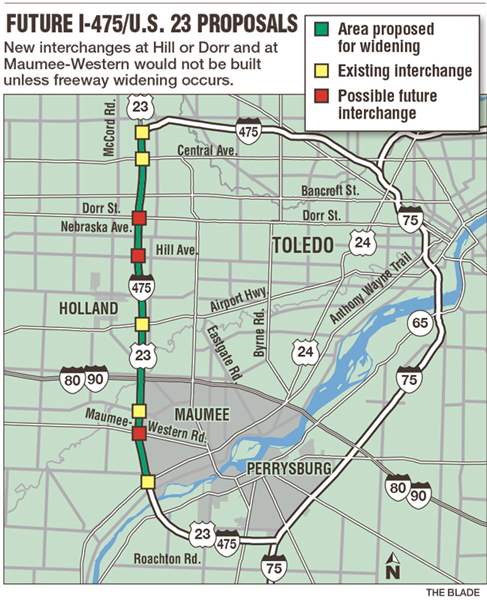
Dorr St., Hill Ave. among options for freeway exit
5/13/2014

A new I-475/U.S. 23 interchange at either Dorr Street or Hill Avenue, long recommended by local transportation planners, now is part of freeway construction proposals for which state funding applications are being prepared.
The Ohio Department of Transportation is preparing an application to the state Transportation Review Advisory Council for widening I-475/U.S. 23 between the Maumee River and Central Avenue. That $60 million project likely would follow projects slated for coming years to modify the I-475/U.S. 23 junction in Sylvania Township and rebuild the nearby Central Avenue interchange.
A companion application is under development by the Lucas County Engineer’s Office to seek state funding for new interchanges at Dorr or Hill and at Maumee-Western Road.
“We’ve formed a group for each interchange” that would coordinate between the county and local governments and arrange the 50 percent local funding match required by state policy for new local-access interchanges, County Engineer Keith Earley said.
A Maumee-Western interchange, which would be braided with the existing Salisbury-Dussel interchange, is expected to cost about $24 million, including $2.3 million in right-of-way the Toledo-Lucas County Port Authority bought last decade to keep options open for such a project.
The port authority has proposed Maumee-Western’s eventual improvement as a new main route to the south side of Toledo Express Airport, supplementing Airport Highway.
Ramps at Hill or Dorr would fall near the middle of a four-mile gap between the I-475/U.S. 23 interchanges at Airport Highway and Central Avenue.
Warren Henry, director of transportation for the Toledo Metropolitan Area Council of Governments, said such an interchange would serve 40,000 people in surrounding neighborhoods who would gain better access to the freeway. “With just two interchanges [at Airport and Central], it just puts so much pressure on those interchanges,” said Mr. Henry, whose organization’s Expressway Needs Study in 2002 included ramps at Dorr or Hill in its recommendations.
A later ODOT study reinforced that recommendation.
The University of Toledo already has pledged $1.5 million of the estimated $6 million local share for that $12 million project if the ramps are built specifically at Dorr, which east of Reynolds Road becomes State Rt. 246 and runs along the southern edge of UT’s main campus.
“We’ve looked at it as creating a new gateway to the university, on a major artery,” said Joseph H. Zerbey IV, who as a UT trustee made the motion during an April 14 board meeting to support the project. “It’ll bring people right down Dorr Street into our new gateway area.”
Mr. Zerbey also is president and general manager of The Blade.
But not everyone who lives in the area near where such an interchange might be built is eager to have more direct freeway access.
Rocleen Reihing, president of the Reynolds Corners Community Development, said the traffic and likely widening on Dorr to support the interchange would be unwelcome in her neighborhood.
“I don’t think we need it on Hill or Dorr,” Ms. Reihing, who has lived on Dorr near I-475 for nearly 45 years, said last week before vowing, “I’m going to do whatever I can to oppose it.”
Mr. Henry conceded the negative impact on people in the immediate area but said “it’s the same issue with similar projects.”
“It’s the needs of the greater region vs. those individual needs. But those needs are certainly going to be considered” during the project-review process, he said.
“Long-term, I think it will have great benefit,” said Lucas County Engineer Keith Earley. “It would definitely take some of the traffic off Central and some off Airport.”
For the Dorr-Hill area, Mr. Earley’s office is part of a four-way Lucas County Transportation Improvement District that also includes Toledo, Springfield Township, and the university. Each would be responsible for identifying grants, tax-increment financing, or other revenue sources to provide a one-quarter share of the local match for the interchange.
Mr. Earley noted that TRAC has to approve funding for the larger I-475/U.S. 23 widening project before the interchanges would even be considered at that level.
Ms. Reihing said some homeowners near her had already received letters from ODOT stating interest in their property, but Theresa Pollick, a spokesman at the department’s district office in Bowling Green, denied that was the letters’ purpose.
Ms. Pollick said the letters were related to the state’s upcoming reconstruction of the Central interchange and were sent out to property owners within a mile of work associated with that project.
ODOT hopes to begin the Central project in the middle of next year and finish it in 2017. A related project to build new lanes for through traffic on southbound U.S. 23 at the I-475 junction north of Central is scheduled to start later this year.
Proposals for the later I-475 projects must be submitted to the advisory council by May 30 if they are to be considered for its next major-construction project plan update, to be issued in January.
Contact David Patch at: dpatch@theblade.com or 419-724-6094.